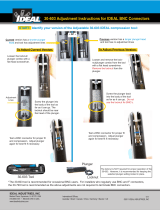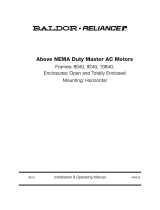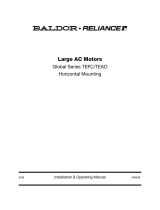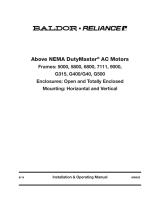Page is loading ...

1
WARNING: To ensure the drive is not unexpectedly
started, turn off, lock out and tag out power source before
proceeding. Failure to observe these precautions could
result in bodily injury.
WARNING: All products over 25 kg (55 lbs) are noted on the
shipping package. Proper lifting practices are required for
these products.
Instruction Manual for Dodge
®
Sleevoil
®
STL and SSL Pillow Blocks
Size 14” Plain
These instructions must be read thoroughly before installation or operation. This instruction manual was accurate at the time of
printing Please see www.baldor.com for updated instruction manuals.
CAUTION: Do not scrape, rebabbitt or otherwise alter this
product. Such action adversely affects bearing performance
and may result in damage to or destruction of equipment.
INSTALLATION
All instructions in this manual pertain to both standard and
short series (SS) pillow blocks with the exception of step 8
following which does not apply to SS style bearings.
1. Check mounting structure making sure it is rigid, level
and well supported. Inspect shaft to ensure it is smooth (32
miro-inch nish or better) and free of burrs or rough spots.
Standard shaft tolerance should be +0.000/0.002” unless
otherwise specied on shaft detail.
2. Disassemble and thoroughly clean all parts of the pillow
block. Housing cap and liner cap are matched to their bases
and should not be interchanged. Housing and liner should
be interchanged as assemblies only.
WARNING: Rust preventives and solvents can be toxic and/
or flammable. Follow directions and safety procedures
recommended by their manufacturers.
CAUTION: Liner assembly has critical machined surfaces
which are easily damaged. Use care in handling to protect
these surfaces. Liner parts should be placed on a soft
CLEAN surface.
3. Position housing base on pedestal so that oil gauge is
in the position specied on the construction drawing. Do
not tighten housing base to pedestal. Apply oil to the
spherical seats in the housing base.
WARNING: Because of the possible danger to person(s) or
property from accidents which may result from the improper
use of products, it is important that correct procedures be
followed: Products must be used in accordance with the
engineering information specified in the catalog. Proper
installation, maintenance and operation procedures must
be observed. The instructions in the instruction manuals
must be followed. Inspections should be made as necessary
to assure safe operation under prevailing conditions. Proper
guards and other suitable safety devices or procedures as
may be desirable or as may be specified in safety codes
should be provided, and are neither provided by Baldor
Electric Company nor are the responsibility of Baldor
Electric Company. This unit and its associated equipment
must be installed, adjusted and maintained by qualified
personnel who are familiar with the construction and
operation of all equipment in the system and the potential
hazards involved. When risk to persons or property may be
involved, a failsafe device must be an integral part of the
driven equipment beyond the speed reducer output shaft.
4. Note location of thermocouple holes in liner base. Set
liner base in housing base so that thermocouple holes in
housing align with holes in liner. Thermocouple holes in
housing base are on side opposite to oil gauge holes (oil
gauge side of housing base is marked “X”). Apply oil to liner
bearing surface.
5. Apply oil to shaft in the bearing area an set shaft in place.
6. Check alignment of pillow block by noting clearance
between housing and shaft at each end of the housing -
clearance should be uniform within 1/32”. Shim bearing
pedestal where possible, otherwise use full length shims
under base as required. Alignment of pillow block should
be as accurate as possible. The self-alignment feature of
the unit is to compensate for normal shaft deection and
possible settling of the supports.
7. Place oil rings around outside of lower liner and over shaft.
Tighten the screws and make sure rings rotate freely on
shaft. Threadlocker can be used to ensure the screws don’t
back out.
Oil rings are shipped disassembled with 2 extra screws.
Oil ring halves are match-marked and MUST NOT be
interchanged. “T-Section” oil rings should be replaced
with upgraded “Trapezoidal Oil Rings”. Part numbers
are in parts list at end of manual.
NOTE: If pillow block has been arranged for cirulating
oil, read section titled “Circulating Oil”.
8. Thrust collars in a fixed non-expansion unit should now
be installed. (Step 8 does not apply to short series (SSL)
style pillow blocks, or shafts with integral collars.) Remove
clamp screws from thrust collars and clean cracked joint
with wire brush. Back off set screws to clear inside of collar.
Place one collar half on shaft so shaft inger groove is next
to liner base in the non-expansion (xed) bearing. Rotate
collar half around shaft and place other half in position.
Bring halves together at joint, making sure match at joint is
perfect and insert clamp screws. There should be no offset
at collar face. Tap halves together and tighten 1/2-13 NC
(Soc). HD clamp screws to recommended torque of 1425
in.-lbs. Repeat above operation for opposite end of bearing.
Assemble two collars on one bearing only. Tap collar
up to face of lower liner allowing a total running clearance
of .015-.017, then tighten 7/8-9NC (Soc) set-screws to
recommended torque of 4100 in.-lbs. Thrust collars do not
apply to short series (SS) style. Collar should run parallel to
end face of liner within .002”.
9. Apply oil to bearing surface of liner cap. Locate cap in place
on lower liner making sure oil rings are in their cavities and
are free to rotate. Install and tighten cap screws to 2100 in.-
lbs.
10. Tighten housing base to pedestal. Torque bolts to 15,000
in-lbs.

2
11. Thread dust seal and seal retainer into groove at end
of housing base and around shaft. Slide free end of seal
retainer through clasp and pull tightly. Hold clasp and
tighten as shown in Figure 1. Cut off excess material and
break off clasp lip, discarding it so it won’t drop in housing
bottom. Seal retainer may be disengaged before installation
by inserting a straightened paper clip between the bands
at the clasp and pulling the free end of the retainer out of
the clasp.
Figure 1 - Seal Retainer Installation
To properly tighten seal retainer, hold clasp stationery with a
screwdriver, grasp free end of retainer with pliers and rotate
pliers toward screwdriver.
Aluminum seals, when specified for the application,
are packaged separately. When using aluminum seals,
discard standard seals and seal retainers packaged with the
housing. To install aluminum seals, rst take O-ring (rubber
cord), wrap it around the shaft in the seal area and cut it to t
the shaft. Disassemble one seal and place one half on shaft.
Locate O-ring in seal groove and rotate seal half around
shaft into housing base groove. Install other half of seal
and tighten clamp screws. For most effective sealing, the
ends of the O-ring must meet. Cementing ends together is
recommended. Install other half of seal and tighten screws.
Install second seal in same manner. If using End Closure,
neoprene discs should be installed at this time. Consult
construction drawing for type of seal recommended.
12. We have replaced SLEEVOIL housing gaskets with 515
Gasket Eliminator. Apply Gasket Eliminator to SLEEVOIL
housing base along outer contour of joint. Special care
should be taken at grommet area.
Back off plunger screw completely and locate housing
cap on base taking care not to damage dust seals. Tighten
housing bolts to 8330 in.-lbs. To reduce chances for leakage,
a non-hardening sealant must be used under cap bolts. The
plunger screw must be loose until the housing bolts
have been tightened. Tighten plunger screw to 4800 in.-
lbs.
These SLEEVOIL Housing have match-marks permanently
stamped on the water pipe grommet pad. These match
marks permanently insure that parts stay paired and critical
orientation of assemblies is maintained.
Cap Loaded Bearings: If shaft must be held down to install
cap, tighten plunger screw to recommended torque of
4800 in.-lbs. with shaft held down. Mark position of plunger
screw. Loosen plunger screw one complete turn and
loosen shaft hold down. Then tighten plunger screw while
tightening shaft hold-down until plunger screw is tightened
to the mark. Do not over-tighten shaft hold-down as this can
misalign the bearing. Remove shaft hold-down and tighten
plunger screw locknut.
NOTE: Do not tighten plunger screw on accompanying
base loaded bearing until cap loaded bearing has been
installed and hold down removed.
Base Loaded Bearings: Tighten plunger screw to
recommended torque of 4800 in.-lbs. and tighten locknut.
tighten housing cap bolts to 8880 in.-lbs.
IMPORTANT: Check and re-torque plunger screw to the
specified torque after 24 hours of initial start-up and then
check and retorque periodically as required.
13. The oil level gauge may be located any distance from the
pillow block by the use of a coupling and pipe of the desired
length. The extended pipe must be supported so that it
remains straight and perfectly level. Use a spirit level - do
not guess. Use pipe sealer on all connections.
14. Remove all pipe plugs and ush liner bore and housing
thoroughly with solvent or cleaner. Reinstall pipe plugs using
pipe sealer. Tighten securely.
15. Each housing base has predrilled holes for doweling bearing
to base plate.
Lubrication and Operation
Since the satisfactory operation of the pillow block depends
almost entirely on the oil lm being maintained between the shaft
and liner bearing surface, it is recommended that a high grade
straight mineral oil with rust and oxidation (R & O) inhibitors and
anti-foam agents be used. Check equipment specications
for specic recommendation of oil viscosity by equipment
manufacturer. Oil viscosity is determined by the equipment
manufacturer and normally specied on the construction drawing
Table 1 - Recommended Oil Viscosity
If not specified by equipment manufacturer
Ambient Temp. Fahr.
During Start Up
Speed SAE/ISO Oil Required
Below -10° All Consult Equipment Manufacturer
-10° All ISO32
32° to 70°
Low ISO68
High ISO32
Above 70°
Low ISO100
High
ISO32 for Light Loads
ISO68 for Heavy Loads
Use high grade, high quality, well rened petroleum oils of the
straight mineral type, with rust and oxidation inhibitor and anti-
foam agent only.
ISO32 - 158 SUS at 100°F; 44 SUS at 210° F
ISO68 - 335 SUS at 100°F; 55 SUS at 210° F
ISO100 - 495 SUS at 100°F; 66 SUS at 210° F
NOTE: The recommended oil temperature at start-up is 70ºF
MINIMUM.
Low ambient and operating temperatures can be as harmful to
the bearing as high temperatures. A heater and thermoswitch
would be required for such applications.
Fill the pillow block with oil to the top of the center circle in the
oil gauge. After placing into operation, remove inspection covers
and check to make sure oil rings are bringing up oil. Operation
should be checked frequently during the rst few days. After some
running of base loaded bearings only, loosen plunger screw 1/4
turn, then retighten. This will allow the liner to align with the shaft.
For cap loaded bearings, follow installation procedure. If noise
develops, check alignment of housing, collar runout, plunger
screw and all operating parts. Check all points and make sure
all screws and nuts are tightened after several days operation.

3
Oil Maintenance Schedule
Maintain oil level above bottom of center circle at all times
while unit is in operation. Drain, ush and rell with oil after 2
to 3 weeks of initial break-in operation. Since the satisfactory
operation of the bearing depends entirely on an oil lm being
maintained between the shaft and the bearing liner surface, it is
recommended that an oil analysis be performed at these regular
intervals.
• Every 3 months for 24 hour/day service
• Every 6 months for 8 hour/day service
Acceptability of oil should be referred to the lubricant manufacturer.
If oil quality is acceptable then repeat this procedure in 3
month intervals. Visually check oil for contamination between
oil analysis checks. Oil service life depends upon several
factors such as ambient conditions, operating temperature and
frequency of bearing starts and stops. It is recommended that
the oil be changed at least once per year for unltered static
applications. Removing contaminants through the use of either
the OLF (Oil Level Filtration) Unit or a circulating oil system can
extend oil service life. Consult equipment manufacturer for more
information.
Oil lm temperature in liner during operation should not exceed
180° F. If in doubt consult equipment manufacturer.
Table 2 - Oil Chart
Oil Volume
Fluid Ounces Quarts Approx. Liters Approx.
704 22 20.82
Volume of oil required to fill pillow block to top of center circle of oil gauge
32 fluid ounces = 1 quart = .94636 liters.
Options
Thermocouple or RTD. A thermocouple is used to sense the
temperature of the pillow block liner in the shaft area, and these
should be on every sleevoil bearing. If a pre-set thermal limit is
exceeded it can trigger a warning or, if desired, send a signal to
disconnect electrical power to the motor.
Two 1/2-14 N.P.S.F threaded holes on the side opposite the
oil gauge holes have been provided as a standard means of
thermocouple mounting. Also nished with the pillow block is a
1/2” x 1/8” adapter bushing to allow adaption of thermocouples
from several manufacturers. Spring loaded thermocouples are
recommended for positive contact.
Install the thermocouple in the location shown on the
construction drawing. Make certain the probe extends into
the liner thermocouple hole. For non-expansion bearing, the
thermocouple should be located in the hole nearest to the
end carrying the thrust load. When the direction of the thrust
load is not known, two thermocouples are recommended. For
expansion bearings, the thermocouple can be located at either
end. Depending on thermocouple and bearing size it may be
necessary to employ a system of pipe nipples and couplings to
achieve proper probe penetration and housing clearance. Use
sealant on all threaded connections including thermocouple
mounting thread. Apply sealant to the pipe plug furnished and
install it in the other hole.
Thermostat and Immersion Heater. An immersion heater is used
to maintain a minimum oil temperature in the pillow block. The
thermostat, used in conjunction with the heater, monitors oil
temperature in the pillow block and regulates the immersion
heater.
If the pillow block has been machined for a heater and thermostat
the threaded mounting holes are usually located in the end face
of the housing base. Install heater and thermostat using sealant
on all threaded connections to prevent oil leakage.
NOTE: Before filling and draining oil from pillow block be
sure heater is off or it will overheat when not submerged in
oil.
WARNING: When installing heater and thermoswitch,
follow direction and safety procedures recommended by
manufacturer. Install wiring in accordance with national
electrical code and local codes.
Circulating Oil. The addition of a circulating oil inlet kit will allow
the bearing to be cooled and lubricated by circulating oil. Please
consult equipment manufacturer to determine if circulating oil is
required. The circulating oil inlet pipes are directed towards the
inspection holes in the liner.
Install oil supply lines to the 1/4” NPSF inlets so that each inlet will
receive an equal amount of oil. Make sure that the oil ows from
the pipes directly into the inspection holes. The drain pipings
should be vented and must be of adequate size to remove the
oil at the specied ow rate. The housing drain must be directed
straight down into a return drain sloping away at 15° or greater
angle. The oiling system should have a means of ltering the oil
to remove any contaminating particles.
When bafes are installed in oil ring grooves of upper liner, oil
rings cannot be used and should be discarded. Bend bafe
so that free end rests on lower liner joint. If the housing drain
is arranged to maintain the proper oil level and oil rings are
specically requested, then oil rings may be used as a safety
measure or back-up oiling system without oil bafes.
End Closure Kits and Auxiliary Seal Kits are available and may
be added at any time without any machining to the pillow block.
Refer to the instructions packaged with the kits for installation
details.
Pillow Block Material Details
Housing: Class 30 Gray Cast Iron
Liner: Class 30 Gray Cast Iron
Babbitt: Lead or Tin Based Babbitt
Oil Rings: Bronze
Seal: HNBR with Stainless Steel Retainer
Aux. Seal: HNBR with Stainless Steel Retainer
Oil Gauge: Stainless Steel, Polypropylene
Hardware: Carbon Steel
Plunger Screw: Carbon Steel
Gasket Eliminator: LOCTITE 515 Sealant
This Sleevoil pillow block could contain lead in the bearing
Babbitt material, please exercise proper precautions in the use,
installation, dismantling and recycling of this unit.
Other Notes:
CAUTION: This product is not to be used for person moving
applications.
NOTE: Care has been taken to keep instruction manuals
accurate and timely. The most recent version of the
instruction manual can be found on our website:
www.baldor.com
Weights:
Table 4 - Weights (lbs.)
Approximate Weights (lbs.)
STL Pillow
Block
SSL Pillow
Block
Collar (2
required)
Replacement
Liner
14” Plain 3400 3000 75 1200

P.O. Box 2400, Fort Smith, AR 72902-2400 U.S.A., Ph: (1) 479.646.4711, Fax (1) 479.648.5792, International Fax (1) 479.648.5895
Dodge Product Support
6040 Ponders Court, Greenville, SC 29615-4617 U.S.A., Ph: (1) 864.297.4800, Fax: (1) 864.281.2433
www.baldor.com
© Baldor Electric Company
MN3059 (Replaces 499962)
All Rights Reserved. Printed in USA.
05/17 PRINTSHOP 500
3059*00517*
Parts for 14” Plain Sleevoil Pillow Blocks
These SLEEVOIL Housings and SLEEVOIL Liners have nameplates attached identied by a six-digit part number which fully identies
the housing and/or liner. Liner nameplates are pinned to the SLEEVOIL liner cap near an oil ring inspection hole. Housing nameplates
are pinned to the housing foot parallel to the shaft. Refer to these part numbers when ordering replacement parts. It is common for
SLEEVOIL bearings to be modied at the factory. These modications can only be identied by the original bearing part numbers.
NOTE: The two digit numbers are for reference only. Order parts by the six digit numbers in the Parts List. Each six digit
number is a complete identification of the part or assembly.
ITEM DESCRIPTION
NO.
REQ’D
PART NUMBERS
ITEM DESCRIPTION
NO
REQ’D
PART NUMBERS
STL SSL STL SSL
Expansion Pillow Block-Plain
431399 430561 34 Plunger Screw Locknut 1 133371 133371
Modular Housing
134239 134243 36 Dust Seal Kit 2 389838 389838
18 Housing Bolt 4 411230 411230 36
Dust Seal
2 – –
Groove Pin 2 409133 409133 38
Seal Retainer
4 – –
24 Gasket Eliminator - 515 2 427359 427359 40 Trapezoidial Oil Ring 2 135736 135736
14 Drain Plug 1 430012 430012 44 Plain Liner Assembly 1 430831 430831
15 Oil Level Plug 2 430014 430014
Liner Dowel
2 – –
16 Circulating Oil Drain Plug 2 430018 430018
Liner Cap Screw
4 – –
17 Thermocouple Plug 2 430012 430012 52
Thrust Collar
2 431389 -
Thermocouple Adapter 1 430081 430081 Auxilliary Seal Kit 2 132822 132822
23 Inspection Cover 2 432199 432199
End Cap Kit
1 132567 132567
28 Oil Gauge 1 430135 430135 54 Thermostat/Accessory Plug 1 430012 430012
32 Plunger Screw Assembly 1 391607 391607 110V 740W Heater Thermostat Combo 1 434729 434729
56 Heater Plug 1 430017 430017
220V 740W Heater Thermostat Combo 1 434730 434730
Expansion Pillow Block includes modular housing, hardware, liner, and oil rings.
To turn an Expansion Pillow Block into a Non-Expansion Pillow Block, add two
thrust collars. SSL-style bearings can only be used as expansion bearings.
These parts make up the assemblies under which they are listed.
Not shown on drawing.
2 required for non-expansion (fixed) pillow block. Includes all hardware required
for mounting. Cannot be used with SSL Pillow Block.
Neoprene disc for use, when desired on installation where shaft does not extend
through housing.
Liner assemblies include cap and base.
/





